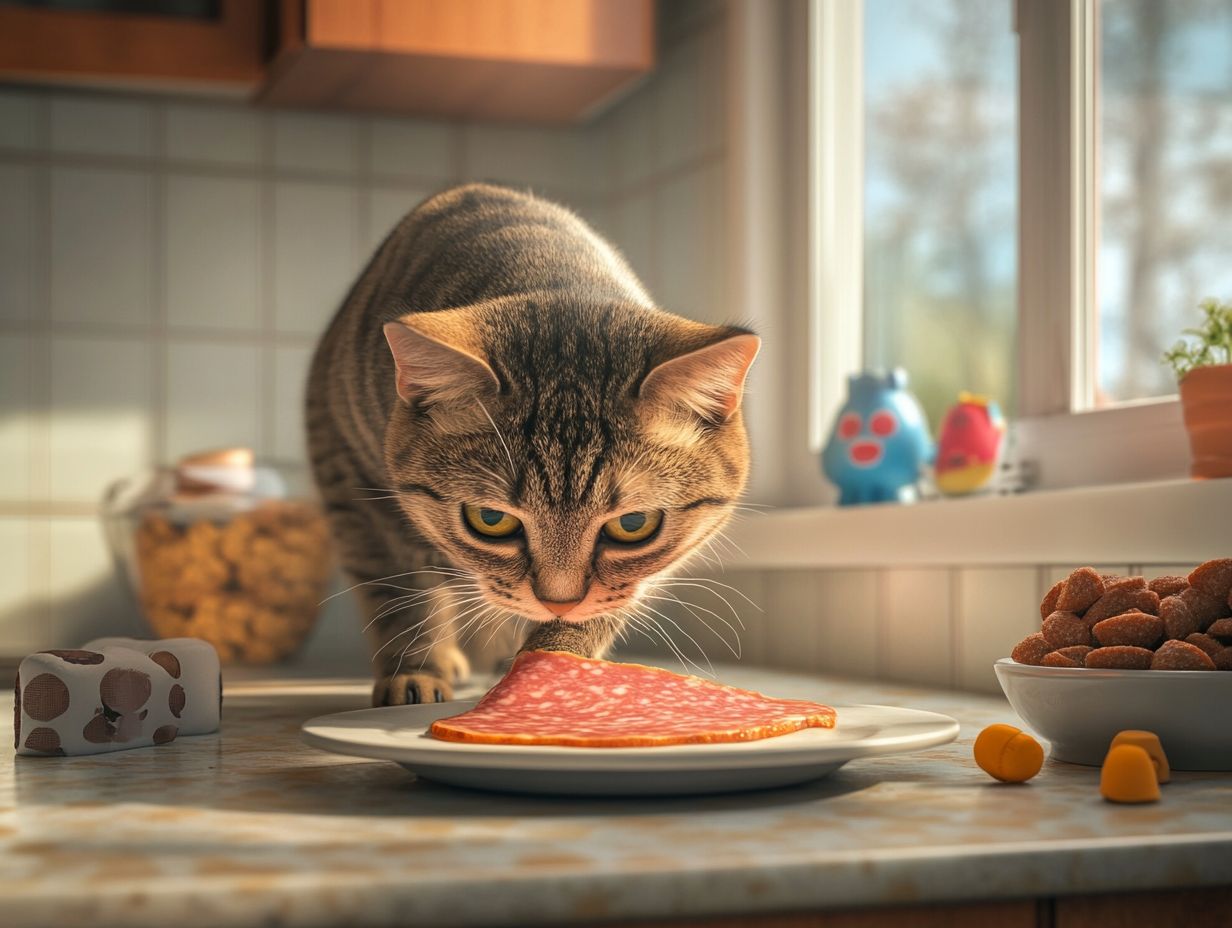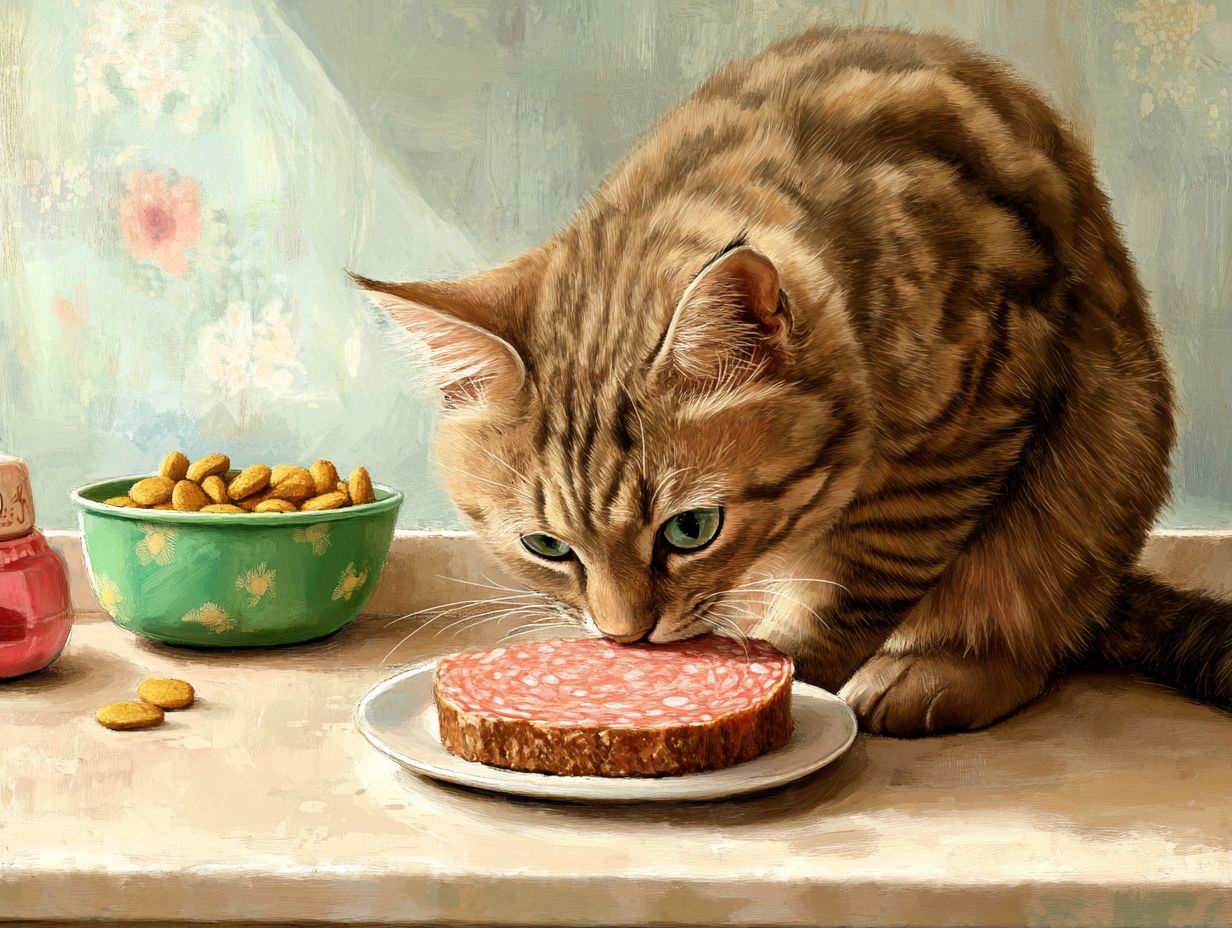Wondering if you can share that tasty baloney with your cat? Let’s find out! Cats are beloved companions, but understanding their nutritional needs can be tricky.
While some human foods seem tempting to share, like baloney, it’s essential to know if they’re safe for your feline friend. This article explores what cats truly need in their diet, the potential risks of feeding them baloney, and healthier alternatives that will keep them happy and healthy.
If you’re determined to give baloney, tips on doing it safely will be shared. Keep reading to ensure your cat gets the best nutrition!
Key Takeaways:
- Cats need a diet mainly made up of meat and should not be fed processed meats like baloney.
- Feeding cats baloney can lead to health issues and should be avoided.
- Safe and healthy treat options for cats include cooked chicken, turkey, or fish.
Understanding Cats’ Nutritional Needs
Cats need meat to thrive because they require a diet primarily rich in protein. Managing dietary fat and sodium levels is essential to prevent obesity, diabetes, and heart disease in cats. Avoiding excessive sodium found in processed meats like baloney is crucial for kidney health.
A well-tailored diet and regular veterinary check-ups are vital for reducing the risk of health problems associated with poor nutrition.
Essential Nutrients for Cats
Cats require a high-protein diet designed to meet their unique needs as obligate carnivores. Protein is crucial for muscle development, immune function, and overall energy. Lean meat options, like chicken, turkey, and beef, contribute positively to their health.
The right fat content is also essential, providing fatty acids that support skin and coat health. Understanding the importance of animal-based protein sources, such as chicken or fish, is key for pet owners planning their cat’s meals.
The Risks of Feeding Cats Baloney
Feeding cats baloney poses several risks due to its high sodium and fat content, as well as harmful ingredients like garlic and sugar. Regular consumption can lead to serious health issues, including digestive problems and salt poisoning.
Potential Health Issues
Health problems from feeding cats baloney include obesity, diabetes, high blood pressure, and gastrointestinal issues. These can manifest as increased thirst, lethargy, and changes in appetite. Long-term, a diet high in processed meats can harm cat health, leading to problems such as kidney issues and heart disease.
Safe Feeding Guidelines
If you choose to share small amounts of cooked, unseasoned meats, consult your vet for personalized advice, ensuring that any human food doesn’t exceed 10% of your cat’s daily caloric intake.
Alternatives to Baloney for Cats
Healthier treats for cats, like chicken, turkey, or beef, offer essential benefits without the health risks of processed meats. Recommended portion sizes for treats include:
- Chicken: 1-2 small pieces (approx. 1 ounce) cooked without seasoning.
- Turkey: 1-2 small pieces (approx. 1 ounce) cooked without seasoning.
- Beef: 1 small piece (approx. 1 ounce) cooked without seasoning.
Conclusion
Prioritize your cat’s health by selecting safe treats and consulting your vet when unsure about their diet!
Safe treat options include lean meats such as chicken, turkey, and beef, which provide high-quality protein along with vital vitamins and minerals. Moderation is key when feeding any treat.
Benefits of Lean Meats
Turkey provides B vitamins for energy metabolism, while chicken offers niacin for healthy skin and coat. Steam or bake the meat without oils or seasonings, and cut it into small pieces for easier consumption.
These healthy treats nourish and strengthen a cat’s muscles, keeping them active and playful.
Risks of Processed Meats like Bologna
How to Safely Feed Cats Bologna
If you decide to offer baloney, do so in moderation. Always ensure it is properly prepared to minimize health risks.
Tips for Moderation and Preparation

- Serve only small pieces infrequently.
- Ensure it is free from toxic additives like onion and garlic powder.
- Opt for high-quality versions with fewer preservatives.
While bologna can be a tasty treat, always check labels for harmful ingredients. Portion sizes should be limited, and watch for any allergic reactions after introducing new foods.
Weighing the Pros and Cons
When deciding whether to feed bologna to cats, weigh the pros and cons. The health risks usually outweigh the enjoyment they may derive from it. Many cats are sensitive to human foods, which can lead to gastrointestinal distress.
Therefore, cats should be fed a well-balanced diet designed to meet their unique nutritional needs and avoid excessive processed foods.
Frequently Asked Questions
Can Cats Eat Bologna?
Yes, cats can technically eat bologna, but it is not recommended as a regular part of their diet.
Is Bologna Safe for Cats?

In small quantities, bologna is generally safe for cats, but it should not be a regular part of their diet.
Why Shouldn’t Cats Eat Bologna Often?
Bologna is processed meat and contains high levels of sodium, preservatives, and additives that can harm cats.
What Happens if My Cat Eats A Lot of Bologna?
Excessive consumption may lead to digestive issues like diarrhea or vomiting, and can cause more severe health problems.
Can Cats Develop Allergies to Bologna?
Yes, cats can develop allergies to certain foods, including bologna. Watch for signs such as itching or swelling.
What Can I Give My Cat Instead of Bologna?
Consider healthier alternatives, such as:
- Cooked chicken or turkey
- Commercial cat treats designed for feline nutrition
- Homemade cat treats using ingredients like fish or rice
Conclusion
In summary, while bologna can be tempting, it should be given only in moderation. Prioritize a well-balanced diet to keep your cat healthy and happy.
Introduction: Choosing safe treats for your cat is essential for their health. Providing appropriate snacks can enhance their diet and strengthen your bond.
Benefits: If you wish to treat your cat, opt for small pieces of cooked, unseasoned meat or fish instead of baloney. These options are rich in protein and meet your cat’s nutritional needs.
Portion Guidelines: A small piece of meat or fish should be no larger than a bite-sized portion. Start with small amounts and observe your cat’s reactions.
Risks: Be cautious of choking hazards and avoid seeds from fruits. Some vegetables can cause digestive upset, so always research before introducing new foods.
Conclusion: Reinforcing safe dietary choices is crucial. Always consult your veterinarian for personalized advice on your cat’s nutrition.